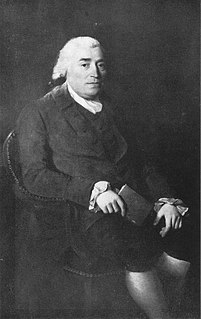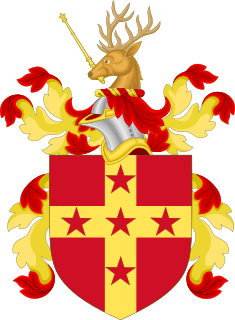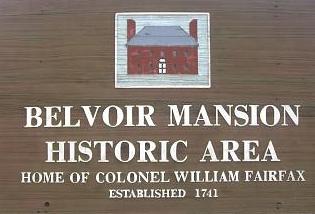
George Mason was an American planter, politician, Founding Father, and delegate to the U.S. Constitutional Convention of 1787, one of the three delegates present who refused to sign the Constitution. His writings, including substantial portions of the Fairfax Resolves of 1774, the Virginia Declaration of Rights of 1776, and his Objections to this Constitution of Government (1787) opposing ratification, have exercised a significant influence on American political thought and events. The Virginia Declaration of Rights, which Mason principally authored, served as a basis for the United States Bill of Rights, of which he has been deemed a father.

Lord Fairfax of Cameron is a title in the Peerage of Scotland. Despite holding a Scottish peerage, the Lords Fairfax of Cameron are members of an ancient Yorkshire family, of which the Fairfax baronets of The Holmes are members of another branch. From 1515 to about 1700 the family lived at Denton Hall.

Martha "Patsy" Randolph was the eldest daughter of Thomas Jefferson, the third president of the United States, and his wife, Martha Wayles Skelton Jefferson. She was born at Monticello, near Charlottesville, Virginia.

Thomas Fairfax, 6th Lord Fairfax of Cameron, was a Scottish peer. He was the son of Thomas Fairfax, 5th Lord Fairfax of Cameron, and Catherine Colepeper, daughter of Thomas Colepeper, 2nd Baron Colepeper.

Sarah "Sally" Cary Fairfax was the wife of George William Fairfax (1724–1787), a prominent member of the landed gentry of late colonial Virginia, and the mistress of the Virginia plantation and estate of Belvoir. She is well-remembered for being the woman George Washington was apparently in love with before his marriage to Martha Dandridge Custis.
Charles Snowden Fairfax, 10th Lord Fairfax of Cameron was an American Democratic politician of California. He held a Scottish peerage. Fairfax was lured west as part of the gold rush. The town of Fairfax, California, is named for him.
John Carlyle Herbert was an American lawyer, planter, military officer in the War of 1812 and politician. He served as a legislator in both Virginia and Maryland, as well as a U.S. Congressman representing Maryland's 2nd congressional district (1814-1818).

The Randolph family of Virginia is a prominent political family, whose members contributed to the politics of Colonial Virginia and Virginia after statehood. They are descended from the Randolphs of Morton Morrell, Warwickshire, England. The first Randolph in America was Henry Randolph in 1643. His nephew, William Randolph, later came to Virginia as an orphan in 1669. He made his home at Turkey Island along the James River. Because of their numerous progeny, William Randolph and his wife, Mary Isham Randolph, have been referred to as "the Adam and Eve of Virginia". The Randolph family was the wealthiest and most powerful family in 18th-century Virginia.
George William Fairfax was a planter in colonial Virginia who represented then-vast Frederick County and later Fairfax County in the House of Burgesses before the American Revolutionary War, by which time he had returned to England. A mentor and good friend of George Washington, Fairfax made opportunities for the younger Washington through his powerful British family, and Washington assisted him afterward by arranging for the sale of his Virginia property after he returned to Britain.
Thomas Bryan Martin (1731–1798) was an 18th-century English American land agent, justice, legislator, and planter in the colony of Virginia and in present-day West Virginia. Martin was the land agent of the Northern Neck Proprietary for his uncle Thomas Fairfax, 6th Lord Fairfax of Cameron (1693–1781) and served two terms in the House of Burgesses.
Virginia Randolph Cary was an American writer. She was the author of Letters on Female Character, Addressed to a Young Lady, on the Death of Her Mother (1828), an influential advice book.

Rev. Bryan Fairfax, 8th Lord Fairfax of Cameron (1736—1802) was an Anglican clergyman and Scottish peer. He was a lifelong friend of George Washington and became the first American-born Lord Fairfax; his predecessors were born in the UK. The Rev. The Lord Fairfax was the first cousin once removed of the seventh Lord. He lived in Virginia. He was the grandson of Reverend the Hon. Henry Fairfax, second son of the fourth Lord. However, it wasn't until 1800 that he was confirmed in the title by the House of Lords.

William Fairfax (1691–1757) was a political appointee of the British Crown and a politician: he was Collector of Customs in Barbados, and Chief Justice and governor of the Bahamas; he served as Customs agent in Marblehead, Massachusetts before being reassigned to the Virginia colony.

Belvoir was the plantation and estate of colonial Virginia's prominent William Fairfax family. Operated with the forced labor of enslaved people, it sat on the west bank of the Potomac River in Fairfax County, Virginia, at the present site of Fort Belvoir. The main house — called Belvoir Manor or Belvoir Mansion — burned in 1783 and was destroyed during the War of 1812. The site has been listed on the National Register of Historic Places since 1973 as "Belvoir Mansion Ruins and the Fairfax Grave."

Thomas Fairfax, 9th Lord Fairfax of Cameron (1762–1846), was an American born Scottish peer, who along with his father, on 11 December 1799, was among the last guests at Mount Vernon before Washington died.
Towlston Grange is an 18th-century plantation in Great Falls in Fairfax County, Virginia, United States. The estate served as a residence for several prominent members of the Fairfax family. Towlston Grange is located at 1213 Towlston Road in Great Falls. There is a photograph of Bryan Fairfax's Towlston Grange in its unrestored state, taken by "The Rambler" of the Washington, D.C. Evening Star newspaper in 1918, that shows a 1+1⁄2-story clapboarded house built in the English tradition.[4]

Thomas Jefferson, the third president of the United States, owned more than 600 African Americans during his adult life. Jefferson freed two of his slaves while he lived; seven others were freed after his death. Jefferson consistently spoke out against the international slave trade and outlawed it while he was president. He privately advocated gradual emancipation and colonization of slaves already in the United States, rather than immediate manumission.

John Hartwell Cocke II was an American military officer, planter and businessman. During the War of 1812, Cocke was a brigadier general of the Virginia militia.
Bushrod Corbin Washington was a Virginia planter and politician, nephew of Supreme Court Justice Bushrod Washington, and grandfather of Confederate soldier and author Bushrod C. Washington (1839-1919) also discussed below.
Ludwell Lee was a prominent Virginia lawyer and planter who served in both houses of the Virginia General Assembly representing Prince William and Fairfax Counties and rose to become the Speaker of the Virginia Senate. Beginning in 1799, following the death of his first wife, Lee built Belmont Manor, a planation house in Loudoun County, Virginia, which today is on the National Register of Historic Places.












